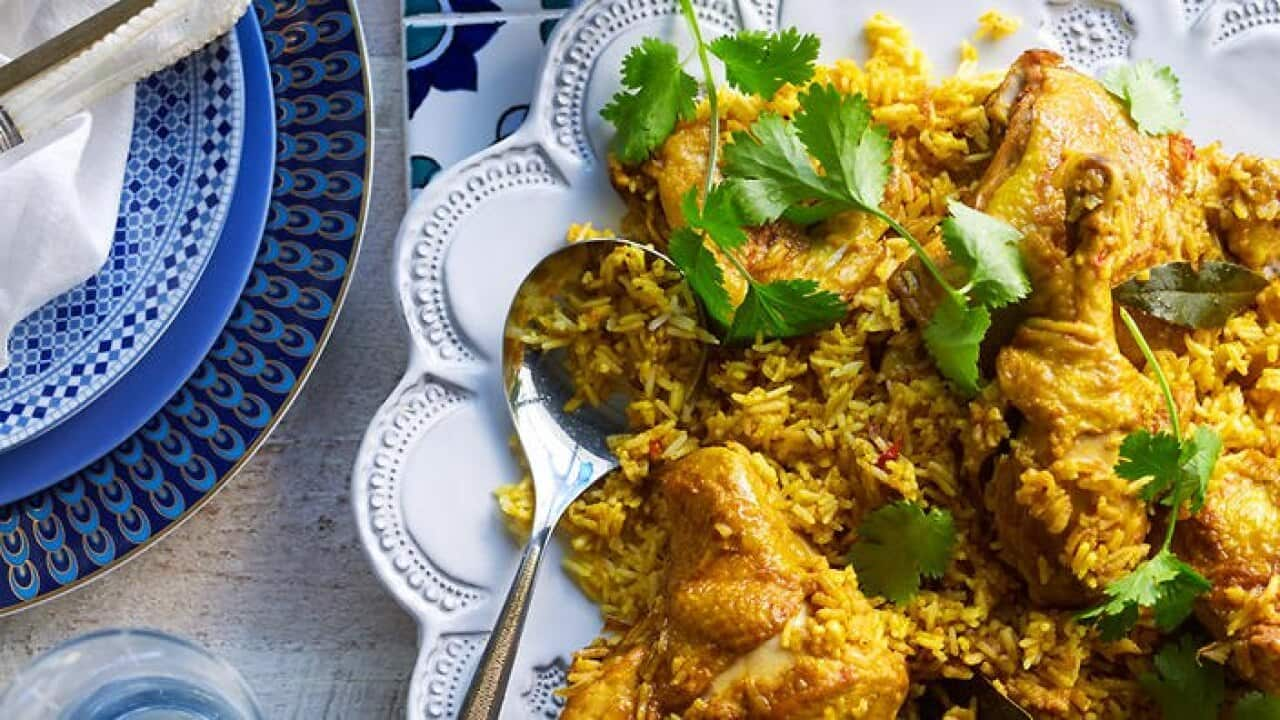My family and I travelled to Egypt during Ramadan when I was 13 years old. This was the last trip our family had to my father's hometown of Alexandria, but it grew my love of Egyptian food and cooking.
Ramadan in the Middle East is a wonderful time – from the breaking of the fast with extended family to the incredible nightlife. Streets fill with delicious food and drinks, and stores stay open till the early hours of the morning for families to buy gifts for children, especially when nearing Eid Al-Fitr (the celebration that marks the end of Ramadan) or Eid Al-Adha (meaning 'the ').
Both Eids also showcase some of the best sweets and desserts Egypt has to offer – and kahk is one of them. In fact, Egyptians' admiration for kahk is aptly expressed by the Egyptian poet, Fouad Haddad, who reportedly : Oh kahk, master of generosity…we will never stop making you.

Amina Elshafei remembers her family and friends gathering to make kahk to break the fast during Ramadan. Source: Amina Elshafei
Ramadan in the Middle East is a wonderful time.
This communal effort was heartwarming. After a number of hours, almost 30 trays and over 600 biscuits were prepared, marked and transferred to a local bakery for baking. Taking pastry dough to a local bakery for baking is widely practised in the Arab world.
Once the kahk were baked, we picked them up, sprinkled them with immense amounts of icing sugar and distributed them among us.
This recipe is an adaption from that time and tips I've learned from family friends. In Egypt, spice vendors create a spice blend called reehet el-kahk that lightly fragrances the dough. It's difficult to buy this blend elsewhere; however, the spices in my recipe are somewhat close to my understanding of what's included in this particular blend.
Photography by Amina Elshafei. Styling by Amina Elshafei. Food preparation by Amina Elshafei.
Kahk
These delicious, crumbly ghee biscuits are lightly spiced and made with a variety of fillings, such as nuts, honey (agameya) and Turkish delight (malban). Sometimes they're left unfilled and served with a generous sprinkling of icing sugar.
Makes approximately 36 biscuits
Ingredients
Kahk dough
- 3 cups plain flour
- 1 tsp baking powder
- ½ tsp yeast granules
- 1 tbsp sugar
- ⅓ tsp ground cinnamon
- ½ tsp ground mahleb/mahlepi
- ⅓ tsp ground cardamom
- ⅓ tsp ground fennel
- ⅓ tsp ground cloves
- ⅓ tsp ground nutmeg
- ⅓ tsp fine salt
- 2 tbsp toasted sesame seeds
- 1 cup and 1 tbsp ghee, slightly melted
- 90 mL full-cream milk, warmed
Agameya (cooked honey) filling with walnuts
- 1 tbsp ghee
- 1 tbsp plain flour
- 1 ½ tsp raw sesame seeds
- 70 g honey
- ⅔ cups finely chopped walnuts
Malban (Turkish delight) filling
- 200 g Turkish delight (rose flavoured) or 300 g pistachio- and rose-flavoured Turkish delight
- 100 g coarsely chopped pistachios
Method
- Preheat the oven to 155˚C (175˚C fan-forced).
- Prepare the kahk dough. Place the dry ingredients in a mixing bowl and mix well.
- Add the ghee and milk and incorporate them to make a well-formed dough. Knead the dough for 5-10 minutes, then cover with cling film to avoid drying. Rest at room temperature for an hour.
- While the dough is resting, prepare the fillings.
- Start with the agameya by melting the ghee on medium heat in a saucepan. Once the ghee is hot, quickly mix in the flour until well combined and no lumps are visible.
- Reduce the heat to low and add the honey and sesame seeds.
- Continue to stir on low heat until the mixture becomes very thick.
- Remove from heat and add the finely chopped walnuts. Combine until the mixture is almost a malleable dough. Allow to cool to room temperature.
- Once the agameya is at room temperature, form the mixture into 1.5 cm small balls and place on a plate.
- To prepare the Turkish-delight fillings, form the plain Turkish delight into 1.5 cm balls, flatten and fill with a few chopped pistachios. Roll up again into a little ball. If using Turkish delight with pistachios, cut and form in 1.5cm balls. Repeat process for either option and place on a plate.
- After the dough has rested for an hour, knead again for 2 minutes.
- Tear a small piece of dough to make a 2 cm ball and flatten it to make a circle approximately ⅓ cm in height. Put one of the balls of filling in the centre and cover the filling with the dough. Gently roll in your hands until the filling is completely covered in the dough and you can't see any holes in the dough.
- Gently press into a kahk or ma'amoul mould of your choice or form into a shape you prefer. You can also use specialised pastry tweezers or a fork to imprint a pattern on the dough. The imprints will later help the icing sugar stay on the biscuits.
- Place the balls on a lightly oiled or baking paper-lined tray.
- Once the biscuits are all done, place them into the preheated oven and cook for 25 minutes, until very lightly golden.
- After cooking, remove from the oven and allow to rest either on the baking trays or on a baking rack until completely cooled.
- When the biscuits have cooled, dust the tops with a generous amount of icing sugar. Assemble onto a platter and serve with tea or coffee.
Note:
- I prefer to sprinkle the icing sugar on the biscuits prior to serving rather than icing them all in one go. The kahk will also keep for longer in an airtight container, unless they all disappear once served, which usually happens.




